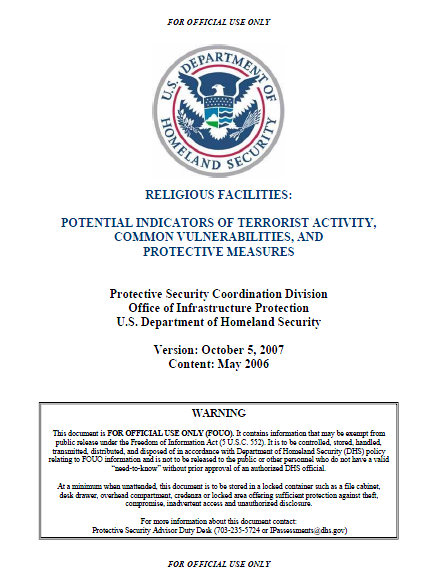The following report is part of a series created by the Department of Homeland Security’s Protective Security Division concerning common vulnerabilities and the detection of terrorist activity at critical infrastructure locations. Several dozen reports from the an earlier version of the series were previously published by this site.
RELIGIOUS FACILITIES: POTENTIAL INDICATORS OF TERRORIST ACTIVITY, COMMON VULNERABILITIES, AND PROTECTIVE MEASURES
- 53 pages
- For Official Use Only
- October 5, 2007
There are approximately 250,400 religious congregations in the United States, consisting of about 138 million members. These members comprise approximately 200 different religions or divisions of religions and meet weekly in more than 240,000 facilities across the country. This report presents the following information related to religious facilities:
- Potential Indicators of Terrorist Activity
- Common Vulnerabilities
- Protective Measures
- Useful References
This report is one of a series of documents that address how our nation can better protect its critical infrastructures and key resources. In addition to this report, a companion document, Overview of Potential Indicators of Terrorist Activity, Common Vulnerabilities, and Protective Measures for Critical Infrastructures and Key Resources (DHS 2006), presents information gathered across a wide range of critical infrastructures. See contacts listed on cover page for additional information.
…
Biological Agent Indicators
• Sales or thefts of large quantities of baby formula or an unexplained shortage of it (the formula can be used as a medium for the growth of biological agents).
• Break-ins or tampering at water treatment or food processing/warehouse facilities.
• Solicitation for sale or theft of live agents/toxins/diseases from medical supply companies or testing/experiment facilities.
• Persons stopped or arrested for possession of unexplained lethal amounts of disease agents or toxins.
• Multiple cases of unexplained human or animal illnesses or fatalities in the surrounding area, especially illnesses not native to the region.
• Sales (to nonagricultural users) or thefts of agricultural sprayers or cropdusting aircraft, foggers, river craft (if applicable), or other dispensing systems. These can be used to spread biological agents. (Also applies to chemical and radiological agents.)
• Inappropriate inquiries regarding local or regional biological material sales, storage, or transportation points.
• Inappropriate inquiries regarding HVAC systems for buildings/facilities by persons not associated with organizations that service these systems. These systems can be used to spread a biological agent throughout a facility. (Also applies to chemical and radiological agents.)

